The in-house vs agency debate has been a hot topic for a while now, writes Amy Gleave, digital marketing manager at Dawn Creative.
My boss, Dave, says that when he started in the design industry 25 years ago, every company would use an agency for their design projects, and freelancers or in-house designers weren’t really commonplace.
Then websites came about, and agencies were used for that too, but people needed amends regularly, so content management systems were developed and used, so much so that some companies started to consider it may be easier to employ a web developer full time. After that, they’d realise the design wasn’t great and saw the benefits of an in-house designer, someone on-hand to deliver content and communication.
But which is the better option? The answer really isn’t that easy. Both represent an investment, and have their own set of advantages and disadvantages. The best option for one company might not be the best for another. Let’s look at the advantages and disadvantages of each, so you can come to your own conclusions.
In-house designer: The advantages
Solely invested in your brand – An in-house designer will be purely focussed on your brand rather than spreading their time across multiple client projects. This is great one one hand, but also means that they may lack inspiration from other industries. Then again, they will know your brand inside out, so things are likely to be very on-brand.
Often cheaper – You have a predetermined monthly spend with an in-house graphic designer. Although this is good for cash flow, the designer’s limited capacity may affect creative output. Your decision may be swayed by your company’s budget, especially if you’re a startup, or not ready to commit to a larger spend on design at the moment.
In-house designer: The disadvantages
Lack of diversity – A single person working on your brand means that all of your output is coming from one person’s mind. An agency would likely have multiple people reviewing every project, giving their input. Diversity is great on so many levels, as we know. This can range from an understanding of multiple topics and issues, to their individual capabilities.
Setup costs – If you need more than just design and require services such as animation, web development and videography, you could end up with some hefty set-up fees as you buy your lighting and recording equipment, all the different softwares required, up-to-date MacBooks, and more. An agency would have a lot of this covered.
HR – Consider the costs and implications of sick pay/leave, holidays, personal issues, career progression, motivation, and the recruitment costs. Someone to manage them, train them, manage complex issues that can arise with any new employee, and make sure they’re happy at work. All things to consider.
Turnover – When an in-house designer leaves, there is usually a period of time before a replacement starts, which may temporarily impact creative output. Who is going to fill that gap?
Agency: The advantages
Blended skills – A single in-house designer may have a limited skillset which could hold you back. When working with an agency, you tend to get more bang for your buck, with agencies often having multiple professionals under one roof. Some have web developers, graphic designers, animators and brand strategy experts all in-house, and a little black book full of contacts for anything they don’t do.
Quality – Agencies have high standards. At least, they should have. There are stringent rules they hold each other accountable to, and work is quality-checked by peers. Combined, the agency will have decades of experience, through projects across a variety of industries. Consider when you are paying a higher rate than you would with an in-house designer that you’re not just getting the work on that one project for the price. You’re getting years of experience, guidance from senior employees at the agency, and more benefits that you may not necessarily see directly.
Direct access – When working with an agency, you would have direct access to the team all year round. Need help with a web design project? You can speak to a web designer. Want something animated in a certain way? Speak to the animator. And when one person is away, someone else will be there to support you. The consideration here is that you may not be prioritised as much as you’d like, and very last minute needs may not always be honoured in the way that an in-house designer may honour them.
Agency: The disadvantages
Cost – Having an agency support you with your creative output can be expensive, depending on how many projects or hours you require. However, this can be scaled up or down throughout the year as a variable cost rather than a fixed cost. Some agencies may not offer this option, but find one that will and you’ll soon find a payment plan that works for you.
Account managers – Some agencies use account managers, who act as an intermediary between you and the creative. This can cause some loss in translation when communicating a brief or feedback. Ensure briefs are comprehensive and you give enough time between briefing the project and the expected completion date to avoid things going wrong.
Summary
The answer to the question “which is best” is… it depends. If you’re a company with a relatively small output not looking to increase that, an in-house designer could be perfect for you. It’s a fixed monthly cost, and they can be there with you in person.
If your goals are to develop your brand in a big way, and have a consistent output varying in creative mediums, then an agency is likely your best bet. There will be more they can do due to varied skill sets, and you can scale up or down the cost depending on your monthly/quarterly marketing goals.
Hopefully, this has helped you make a decision!












